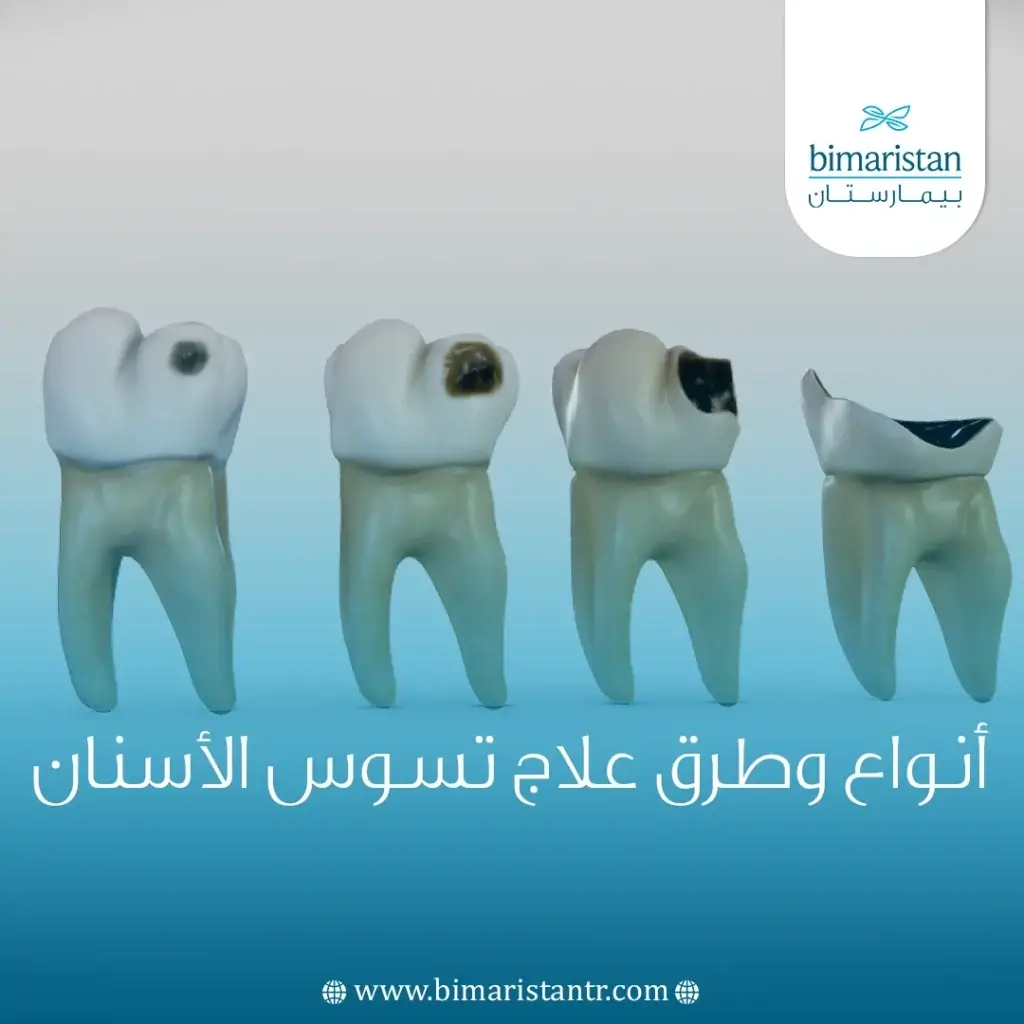تسوس الأسنان هو أحد أكثر مشاكل الأسنان شيوعاً عند الأطفال والبالغين يتطور على عدة مراحل، سنتعرف في المقال على أنواع تسوس الأسنان وخيارات علاج تسوس الأسنان في تركيا.
التسوس هو مرض يسبب تدمير الميناء وهو السطح الخارجي الصلب للسن، مع تقدم التسوّس يمكن أن يهاجم الطبقات العميقة من الأسنان مما يؤدي إلى ظهور تجاويف الأسنان، أما إذا تُرك ولم يتم علاج تسوّس الأسنان فسوف يضر أسنانك ولثتك لدرجة الحاجة لخلع الأسنان.
يمكن للأشخاص من جميع الأعمار من الطفولة حتى سن الشيخوخة أن يصابوا بتسوس الأسنان بمجرد أن يكون لديهم أسنان.
يتعرض الأطفال الصغار لخطر الإصابة بأنواع تسوس الأسنان المختلفة، في مرحلة الطفولة المبكرة قد يصاب الطفل بتسوس الأسنان الناتج عن زجاجة الرضاعة وهو تسوس شديد يصيب أسنان الطفل.
العديد من كبار السن يعانون من انحسار وتراجع اللثة الذي يسمح للبكتيريا المسببة للتسوس في الفم بالتلامس مع جذر السن، فيمكنهم أن يصابوا بالتسوس على أسطح الجذور المكشوفة لأسنانهم.
ما هو تسوس الاسنان؟
تبدأ جميع أنواع تسوس الأسنان عندما تلتصق الأطعمة الغنية بالكربوهيدرات مثل الفاكهة أو الحلوى أو الخبز أو الحليب بسطح أسنانك ستقوم البكتيريا الموجودة في فمك بعد ذلك بهضم أجزاء الطعام هذه وتحولها إلى حمض مما يؤدي إلى تراكم البلاك (اللويحة) على أسنانك.
نظراً لأن البلاك حامضي فله دور أساسي في حدوث النخر حيث يمكنه إذابة طبقة الميناء على أسنانك وإنشاء ثقوب فيها تسمى التجاويف.
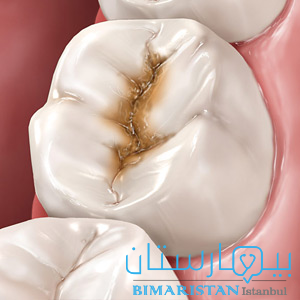
أسباب تسوس الاسنان
يمكن أن تكون بعض العادات الصحية والحالات الطبية من اسباب تسوس الاسنان ونخرها، مثل:
- عدم تنظيف الأسنان بالفرشاة والخيط بانتظام
- كثرة تناول الوجبات الخفيفة
- تناول الكثير من الأطعمة السكرية التي تنتج الأحماض
- تناول الأطعمة الغنية بالكربوهيدرات مثل الخبز
- عدم الحصول على ما يكفي من الفلورايد
- التدخين
يجب التخلص من البلاك الذي يسبب التسوس، يمكنك عكس التجاويف المبكرة بالعلاج الصحيح ولكن لا يمكنك عكس التجويف وعلاجه بمجرد أن يصبح عميقاً بدرجة معينة.
العوامل المؤهبة لحدوث التسوس
قد يكون لدى الشخص فرصة أكبر للإصابة ببعض أنواع تسوس الأسنان في حال:
- لديه فم جاف
- لديه ميناء ضعيف بسبب الوراثة أو المرض
- لديه اضطراب في الأكل مثل فقدان الشهية أو الشره المرضي
- لديه حالة الارتجاع المعدي المريئي المعروف أيضاً باسم الارتجاع الحمضي
أعراض تسوس الأسنان
وتشمل هذه الأعراض:
- ألم الأسنان المفاجئ خاصة عند تناول أشياء باردة أو ساخنة أو حلوة
- بقع داكنة على الأسنان
- ألم عند العض
- ظهور التجاويف النخرية
- حشوات متخلخلة
- تجاويف في الأسنان
- انحصار الطعام في الأسنان
- صعوبة في مضغ بعض الأطعمة
- خراجات أسنان تسبب الألم أو تورم الوجه أو الحمى
تشخيص تسوس الأسنان في تركيا
يمكن العثور على تسوس الأسنان أثناء فحص الأسنان المنتظم، قد يبدو تسوس الأسنان المبكر على شكل بقعة بيضاء على السن وإذا كان التسوس أكثر تقدماً قد يظهر على شكل بقعة داكنة أو حفر في السن.
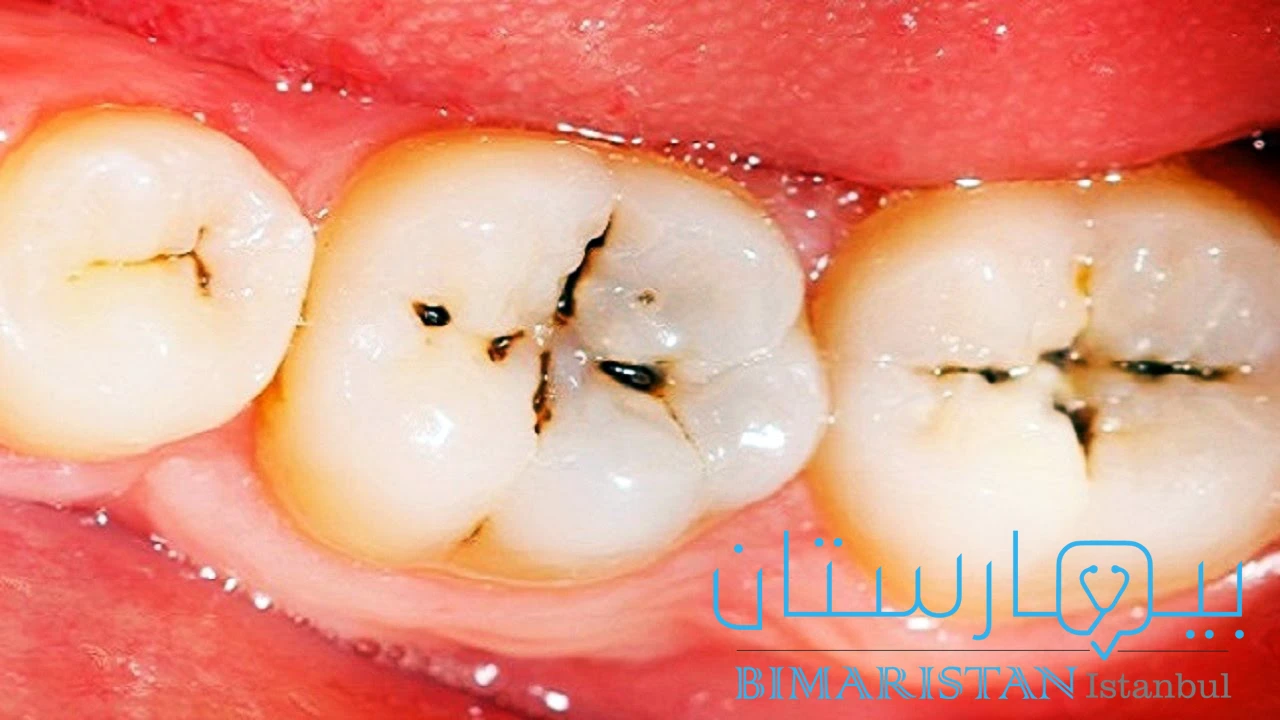
يمكن لطبيب الأسنان أيضاً فحص نعومة سطح الأسنان أو أخذ صورة أشعة سينية X-ray التي يمكن أن تظهر التسوس.
أنواع ومراحل تسوس الأسنان
تختلف أنواع تسوس الأسنان مع مرور الوقت بتطور التسوس عبر خمس مراحل سوف نلقي نظرة على كل واحدة.
-
نزع المعادن
خلال المرحلة الأولى لتسوس الأسنان تبدأ الطبقة المصابة الخارجية للأسنان والمعروفة باسم الميناء بالضعف بسبب وجود طبقة البلاك، يعد الميناء أقسى مادة في الجسم فهو أصلب من العظام ومع ذلك فإن تعريض السن للحمض الناتج عن البلاك يمكن أن ينزع المعادن ويسبب ضعف الميناء.
عندما تبدأ عملية زوال التمعدن من المحتمل أن تبدأ في رؤية بقع بيضاء على أسنانك هذا هو المكان الذي بدأت فيه اللويحة في إزالة ميناء الأسنان.
يمكنك عكس الضرر الذي تسببه اللويحة في المرحلة الأولى عن طريق استخدام غسول الفم بالفلور في كثير من الأحيان أو الحصول على علاج بالفلور من طبيب الأسنان ولكن في حال تطور النخر وتقدم فستحتاج لعلاج تسوس الأسنان في العيادة باستخدام الحشوات.
-
انهيار الميناء
إذا لم يتم علاج تسوس الأسنان وسمحت للميناء بالاستمرار في التهدم ستبدأ البقع البيضاء في التحول إلى اللون البني وينتقل إلى المرحلة الثانية من تسوس الأسنان حيث يبدأ الميناء في التدهور ويبدأ تسوس الأسنان في التكون.
-
تسوس العاج
إذا لم يتم علاج تسوس الأسنان وملء التجاويف في الوقت المناسب فقد ينهار العاج المصاب في النهاية أيضاً، وهو جزء من السن يقع تحت الميناء والذي يكون أكثر ليونة من الميناء وهو أكثر حساسية للتلف الحمضي.
في هذا النوع من أنواع تسوس الأسنان سيزداد التسوس من هذه النقطة فصاعداً إذا لم ترَ طبيب الأسنان، ستعرف أنك في هذه المرحلة الثالثة من التسوس عندما تبدأ في الشعور بحساسية أسنان شديدة أثناء تناول المشروبات الساخنة أو الباردة خاصة الأنواع السكرية وكذلك أثناء تناول الطعام.
إذا تم اكتشاف تسوس العاج في وقت مبكر يمكن إصلاحه بالحشو، إذا حدث ضرر كبير فمن المرجح أن يقوم طبيب أسنانك بإزالة الجزء المتسوس من أسنانك ويضع تاج فوق بنية السن المتبقية.
-
تضرر اللب
إن من أخطر أنواع تسوس الأسنان هو عندما يصل النخر إلى اللب السني أو كما يشاع تسميته عصب السن، وهو الطبقة الموجودة تحت العاج في الجزء السفلي من السن ويضم الأوعية الدموية والأعصاب التي تحافظ على الأسنان وتؤمن الإحساس فيها.
بمجرد عدم علاج تسوس الأسنان وانتشاره في اللب قد تصاب بالاتهاب الحاد فيبدأ سنك في التورم ويبدأ الضغط في الازدياد وذلك لأن أسنانك لا يمكن أن تتمدد مع اللب مما يسبب الآلام.
تتضمن المرحلة الأخيرة من تأذي اللب موته المعروف أيضاً باسم نخر اللب.
قد يواجه المصابين الأعراض التالية عند عدم علاج تسوس الأسنان وحصول تموت اللب:
- تغير لون السن إلى الرماد
- الأسنان ذات رائحة كريهة
- تورم حول السن
- طعم كريه في فمك
ستحتاج إلى علاج قناة جذر السن لعلاج لب السن التالف.
تكون الخراج
في هذه المرحلة الأخيرة عند عدم علاج تسوس الأسنان عند المريض تدخل أنواع معينة من البكتيريا داخل اللب المتحلل مما يؤدي عادةً إلى الإصابة بالعدوى.
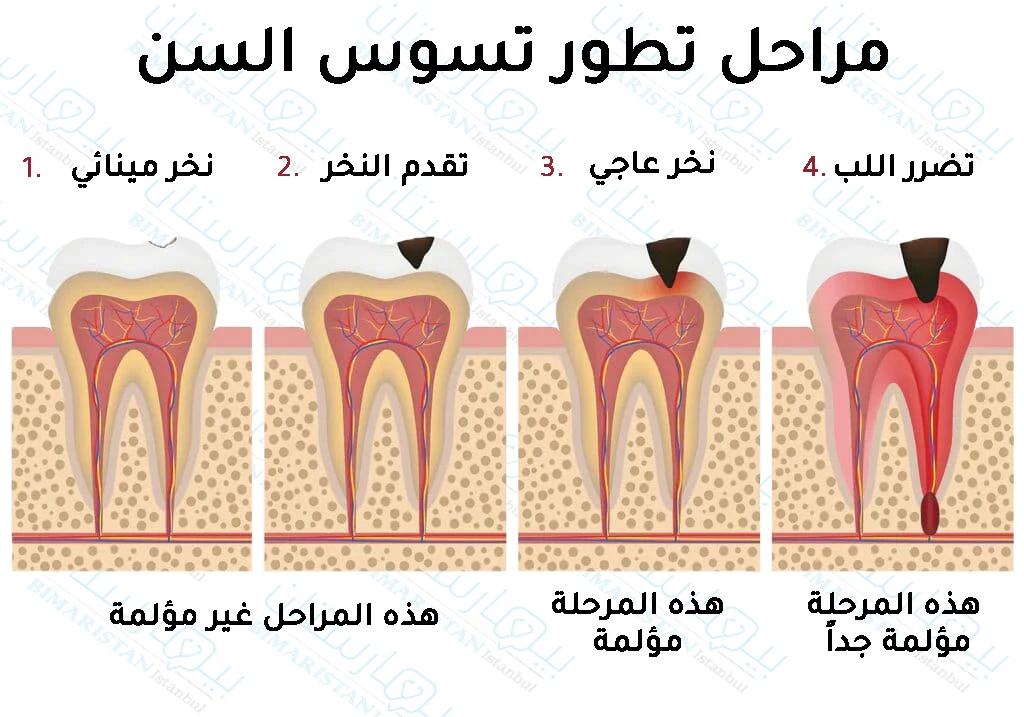
في النهاية قد يتشكل خراج في الجزء السفلي من السن مما يسبب ألماً شديداً تكمن خطورته بإمكانية أن ينتشر إلى بقية الفم واللثة والوجه والفك مسبباً حالة طبية تدعى بخناق لودفيغ وهي حالة مهددة للحياة تحتاج علاجها عند الطبيب المختص فوراً.
أضرار تسوس الأسنان على الجسم
- تشكل خناق لودفيغ المهدد للحياة
- انتقال الجراثيم إلى أماكن آخرى في الجسم مما يسبب التهاب بطانة صمام القلب
- التهاب المنصف
طرق علاج تسوس الأسنان في تركيا
يمكن لطبيب الأسنان أن يوصي بعلاج تسوس الأسنان المناسب للشخص اعتماداً على نوع التسوس الذي تم الإصابة به، يمكن أن يشمل علاج تسوس الأسنان ما يلي:
علاجات الفلور في المراحل المبكرة (علاج التسوس البسيط)
الفلورايد معدن يمكن أن يساعد في تقوية الميناء، يمكن لطبيب الأسنان استخدام العلاج الفلوري بأشكال مختلفة للمساعدة في وقف وحتى إصلاح الضرر الذي أدى إليه السوس.
ويمكن لطبيب الأسنان أن يطبق علاجات الفلوريد الاحترافية مباشرة على الأسنان، فإنه عادةً ما تكون علاجات الفلورايد سريعة ولا تستغرق سوى بضع دقائق، يأتي الفلوريد على شكل هلام أو ورنيش أو رغوة أو محلول. حيث يقوم بـ علاج التسوس بدون حفر.
حشوات الأسنان المحافظة في تركيا
عندما يحدث تجويف الأسنان يكون الحشو خياراً علاجياً لعلاج تسوس الأسنان، بعد حفر السن لإزالة أي تسوس يقوم طبيب الأسنان بإزالة الأجزاء االمتأذية من السن وتشكيل التجويف السني ليلائم الحشوة.
أثناء علاج تسوس الأسنان يملأ طبيب الأسنان التجويف بالحشو بطريقة مباشرة باستخدام مواد مثل الأملغم أو الراتنج المركب (الكومبوزيت) أو الذهب أو الفضة أو في القليل من الحالات بطريقة غير مباشرة باللجوء إلى الحشوات المصبوبة inlays/onlays.
لا تتردد بالتواصل معنا، مركز بيمارستان عائلتك في تركيا نقدم لك استشارات مجانية على مدار الساعة.
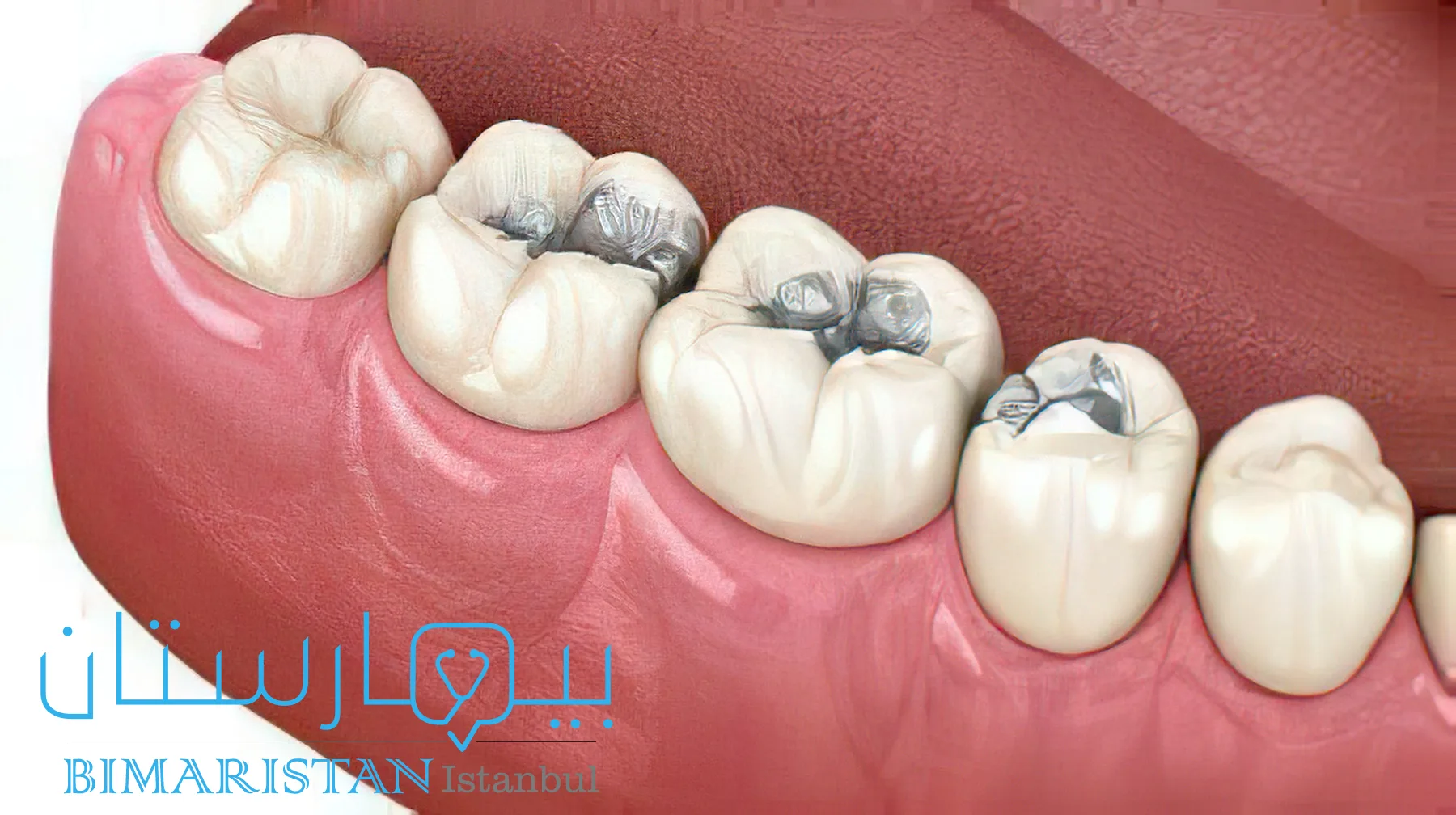
التيجان
وفقاً لـ ADA قد تتطلب النخور الكبيرة التي تتقدم بسبب عدم علاج تسوس الأسنان تاجاً بدلاً من الحشو.
لوضع التاج يقوم طبيب الأسنان أولاً بإزالة الجزء الخارجي من السن وكذلك أي تسوس موجود ومن ثم سيأخذ طبيب الأسنان طبعة عن السن رقمية أو تقليدية، ويقوم بتركيب تاج مؤقت حتى يصبح التاج الدائم جاهزاً للتركيب، عادةً بعد أسبوع إلى أسبوعين.
علاج قنوات الجذور (علاج التسوس العميق)
يمكن لطبيب الأسنان إجراء معالجة لجذر السن للمساعدة في منع الحاجة إلى القلع عند تضرر لب السن عند عدم علاج تسوس الأسنان في المراحل الأولى.
وفقاً للجمعية الأمريكية لأطباء الأسنان يقوم طبيب الأسنان أولاً بتخدير السن قبل إزالة العصب ثم يقوم بتنظيف وتشكيل قناة الجذر داخل السن، قد يقوم طبيب الأسنان أيضاً بوضع دواء ضمن السن إذ خصائصه المطهرة تساعد في التخلص من أي بكتيريا.
سيقوم طبيب الأسنان بعد ذلك بملء قنوات الجذر بمادة شبيهة بالمطاط ويضع تاجاً أو حشوة على السن لاستعادته وتقويته.
خلع الأسنان
عدم علاج تسوس الأسنان وإهماله قد يؤدي إلى فقد الأسنان، قد يوصي طبيب الأسنان الشخص بخلع الأسنان إذا تسبب تسوس الأسنان في أضرار جسيمة.
سيقوم طبيب الأسنان أولاً بتخدير السن المتضرر، بمجرد إزالة السن سيوصي طبيب الأسنان بتعليمات ما بعد القلع.
قد يلاحظ الشخص تورماً أو ألماً بعد قلع السن وهو أمر طبيعي ومع ذلك إذا لاحظ الشخص أياً من الأعراض التالية فعليه الاتصال بطبيب الأسنان و التماس العناية الطبية على الفور:
- حمى
- غثيان
- تقيؤ
- ألم شديد أو تورم أو نزيف
- ألم يزداد بمرور الوقت
منع تسوس الأسنان والوقاية منه
الأهم من معرفة كيفبة علاج تسوس الأسنان هو معرفة كيفية منع التسوس وإيقاف تراكم البلاك والبقايا الطعامية، يمكنك القيام بذلك عن طريق:
- اغسل أسنانك بمعدل مرتين بشكل يومي على الأقل باستخدام أنواع من معجون الأسنان التي تحتوي على الفلورايد.
- الشطف والتنظيف بالخيط في كل مرة تأكل فيها شيئاً لزجاً أو حمضياً أو يحتوي على نسبة عالية من الكربوهيدرات وخاصة الشوكولاتة والحمضيات.
- استخدام وسائل تنظيف ما بين الأسنان والخيط للتخلص من أكبر قدر ممكن من بقايا الطعام لمنع تطور تسوس الأسنان من الجنب.
- استخدام غسولات الفم الحاوية على الفلورايد والمضادة للنخور مرة واحدة على الأقل يومياً للتخلص من البلاك.
- اطلب من طبيب أسنانك تطبيق مواد سادة للوهاد والميازيب للأسنان على الأضراس لحمايتها و الوقاية من النخور.
- شرب الماء الحاوي على الفلور.
- زيارة طبيب أسنانك مرة واحدة على الأقل سنوياً لإجراء الفحوصات وتنظيف الفم.
- من المهم أن تراقب ما تأكله إذا كنت تريد منع تسوس الأسنان، تجنب شرب المشروبات الغازية الحمضية وتجنب تناول الوجبات الخفيفة الحلوة واللزجة مثل ألواح الحلوى والكراميل.
- إذا كنت تأكل هذه الأطعمة فتأكد من تنظيف الأسنان بالفرشاة مباشرة بعد تناولها، كلما طالت مدة عدم تفريش أسنانك بعد تناول هذه الأنواع من الأطعمة زادت احتمالية إصابتك بتسوس الأسنان.
- على الرغم من ذلك قد يعاني بعض الأشخاص من تسوس الأسنان لذلك يتوجب عليك زيارة طبيب الأسنان للتعرف على أسباب تسوس الأسنان رغم تنظيفها. حيث قد يكون هنالك بعض المشاكل في بنية الأسنان بحد ذاتها.
